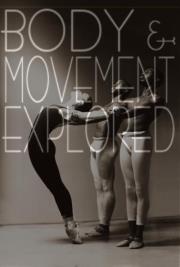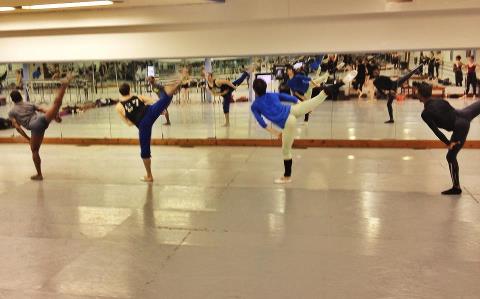 The art scene has progressed immensely in Columbia, SC over the past decade, and while Columbia City Ballet may have previously seemed to lag behind, performing the same pool of two- and three-act story ballets since William Starrett took over, only creating new ones every few years, the company seems to be moving forward of late and progressing along with the city.
The art scene has progressed immensely in Columbia, SC over the past decade, and while Columbia City Ballet may have previously seemed to lag behind, performing the same pool of two- and three-act story ballets since William Starrett took over, only creating new ones every few years, the company seems to be moving forward of late and progressing along with the city.
On Friday, February 20 at 7:30 PM Columbia City Ballet presented its third annual Body & Movement Explored series. This event is a departure from what the company typically performs. Starrett has said this is an experimental project for the dancers as well as emerging choreographer to see if it can bring in an audience, and one day be presented on a bigger stage.
It is always exciting to see dancers you have become familiar with onstage be able to share another part of themselves with the audience. Most of the choreography was by Columbia City Ballet dancers. This year marks the first time choreographers came from out of state and volunteered their time to create works, including Rachel Leonard, a freelance choreographer from Florida; Jenny Broe, Owner of StudioFX in Charleston; Kevin James of Smuin Ballet; and former CCB principal dancer, Wayland Anderson. The Columbia City Ballet choreographers included soloist Philip Ingrassia, and corps members Ashley Concannon, Amanda Summey, and Denis Vezetiu.
Mr. Vezetiu choreographed two pieces as well as co-choreographed one with Ms. Concannon. His most captivating was his pas de deux, "Walk," which showcased his incredible strength and control as he manipulated dancer Nadine Tetrick around his body. She never touched the floor, as he was always controlling her. Her port de bras reacted to him like movement through water. They were one body moving together creating something beautiful to Ludovico Einaudi's minimalist score.
Ludovico music was used in four different pieces, as well as other minimalist composers including Philip Glass and Zoe Keating. What is interesting is how these composers created an atmosphere and texture with their music, rather than becoming monotonous because of its repetitiveness, lack of dynamic contrast with only slight rhythmic and melodic variations.
Jenny Broe, one of the visiting choreographers, created an enthralling contemporary piece of work to an up-tempo, club remix version of Bryan Adams’ “Wicked Games.” The choreography was seamless throughout, creating a battle between the dancers as to who could out dance whom. There was no pause for the dancers who moved from one structure to the next in groups or in pairs. The dancers would enter or leave the arena by walking fiercely like runway models. The other stand out choreographer was Rachel Leonard, who choreographed the opening piece “Speak” as well as the finale “Garcons et das Filles et des Bancs”. The last piece was set to operatic music with four sets of couples divided by gender and sitting on benches. There were phallic movements and a titillating flirtation from the four girls and four boys making it humorous and engaging fun. The boys unfortunately, missed some of the musical cues that would've made her vision really come to life.
Starrett recently commented that this is an experimental show trying to find an audience and support. He choreographed a pas de deux, “All for You,” for real life married couple Ingrassia and Autumn Hill. It was a tongue and cheek country western, on the bayou piece with choreography familiar to anyone who has seen Starrett’s previous work. For the music he collaborated with Josh McCaa who is married to CCB principal, Claire McCaa. McCaa’s country western music and voice were great, but didn’t quite sync up to the choreography. Starrett’s work with CCB is typically classical story-line fairytale ballets, like CCB’s upcoming “Cinderella.” “All For You” gave Starrett a chance to try something on a smaller scale and in a less-serious mood. It might have seemed that Starrett was going for laughs at times rather than substance, but maybe the programming of a light piece provided a good contrast with the passionate and personal work of the other choreographers.
Amanda Summey's piece “Identity Crisis” was fresh and thought provoking. Hip-hop, with elements of contemporary ballet, the eight women were wearing red masks that covered the lower half of the face and wearing street clothes. With their faces covered, they had to rely completely on body movement for expression. The music used was just a rapper with no instruments, but the rap voices layered on top of each other, creating a vocalized rhythm. Summey is a poly-artist: a visual artist and sketcher, ballet dancer, choreographer, and theater graduate from Northwestern University, she brings graffiti street art and intellectualism to her work.
The dancers who stood out were the constant duo, Bonnie Boiter-Jolley and Claire Richards. They were in the most pieces but were always paired together. Although these two compliment each other physically – they are tall, slender and blond – it would have been nice to see them dance separately, for each brings her own versatility to the stage.
In the future, CCB should model this show after other workshops around the country by auditioning choreographers to present full-length works (20-30 minutes) so the dancers can get fully invested in the work. There are theaters that can host such an event, other than the informal black box, that won’t run up the cost as much as putting it on at the Koger Center would. Having a professional event at such an informal space has its downsides: there isn’t enough lighting to explore the space, and the sound was a little low, which in turn meant we could hear every step and breath taken on stage. I believe the Columbia arts community will support a mixed-repertory series. Body & Movement Explored should be expanded and promoted bringing one-act ballets of various lengths with plot-less rather than story line structures. I think the series could be artistically and fiscally viable.


